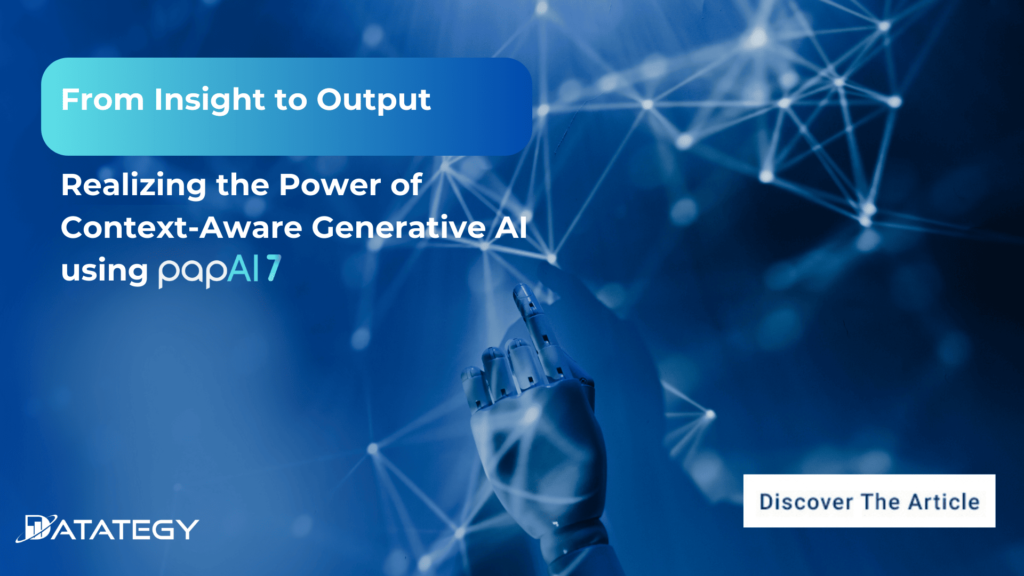Scaling RAG Systems in Financial Organizations Artificial intelligence has emerged...
Read MoreFrom Insight to Output:
Realizing the Power of Context-Aware Generative AI using papAI 7
Table of Contents
ToggleContext-Aware Generative AI is a ground-breaking idea that pushes AI-driven creativity to new heights in the dynamic field of artificial intelligence (AI). By including context awareness into the practice of content generation, this cutting-edge paradigm goes beyond what is possible with conventional AI. Imagine an AI system that not only creates material but also understands and adapts to the circumstances around it, producing information that is pertinent and truly resonates with the audience it is meant for.

The potential of AI is expected to be expanded because of this combination of generative power and contextual intelligence, especially in content creation, communication, and problem-solving. We will see in this article how papAI 7 can enhance AI generative capabilities for your specific needs.
Context-Aware Generative AI: What Does It Mean?
The concept of ” Context-Aware Generative AI ” represents the idea that AI may produce content while also understanding and adapting to its environment. It is an AI paradigm that bridges the gap between the processing of raw data and comprehension that is comparable to that of a human. Imagine an AI system that considers the who, what, where, when, and why—the basic foundations of context—in addition to just generating text, images, or replies.
For instance, the user may choose the length of the text to automatically produce product descriptions on the latest version of papAI. Using this criterion, the user may create a description that is appropriate for his online store, social media platforms, and internal brochures while still taking into account the limitations of the latter.

In a context where the challenges of content creation are multiplying with the emergence of different communication channels, context-aware gen ai will provide all content creators with reliable AI that is adapted to their real needs.
Hocine OUSMER
Head Digital & Communication Manager - Datategy
Leveraging Large Language Models for Precise Output
The capabilities of Large Language Models (LLMs) have spurred an important shift in the field of artificial intelligence regarding how robots comprehend and produce writing that is similar to that of humans. These models, which were pre-trained using enormous datasets, have shown adept at replicating linguistic patterns and producing writing that makes sense. When LLMs are enhanced for context awareness, however, their real magic manifests, lifting their output from simple coherence to contextual relevance.
LLMs can be improved by applying these pre-trained models to certain domains, businesses, or even individual applications. They are given a broad understanding of language through pre-training, but fine-tuning honed their comprehension to fit the subtleties of real-world circumstances. Through this approach, a model’s ability to produce material that connects with certain audiences and objectives is made possible in addition to its general language skills.
A fine-tuned LLM is capable of creating information that is both linguistically and contextually appropriate by using contextual clues and limits. Fine-tuned LLMs are adept in capturing the nuances of context, whether it’s adjusting to different tones for various social media networks, aligning with industry jargon, or even personalizing replies based on user interactions.

mPLUG-Owl architecture for improved image captioning using LLMs
Real-World Applications
Applications for Context-Aware Generative AI are numerous and important. Anyone may utilize the dynamic generative AI of papAI 7, from content creators wishing to streamline their workflow to marketing specialists striving for customized campaigns:
Case Study:
From Concepts to Tangible Content -
Watch papAI 7 Demonstration
Watch the #papAI7 demo and redefine your possibilities, this live demo shows off the innovative prowess of the latest iteration of papAI, which promises to revolutionize content creation by harnessing the power of #adaptability and #scalability:
Create your own AI-based generative tool with the papAI solution and increase your productivity
You have the opportunity to completely transform your content creation strategy with the papAI solution. With the help of our platform, you can create an AI-driven toolset that is specifically tailored to meet your requirements. You can improve the accuracy and efficiency of your content creation efforts by using state-of-the-art machine-generated learning approaches.
Book your personalized demo today to discover how the papAI solution can transform your AI landscape. Our team of experts can help you create a custom AI-based tool that meets the unique needs of your organization.
Interested in discovering papAI?
Our AI experts are at your disposal for any questions
How AgenticAI is Transforming Sales and Marketing Strategies
How AgenticAI is Transforming Sales and Marketing Strategies Agentic AI...
Read More“DATATEGY EARLY CAREERS PROGRAM” With Abdelmoumen ATMANI
“DATATEGY EARLY CAREERS PROGRAM” With Abdelmoumen ATMANI Hello, my name...
Read MoreIntroducing the Error Analysis Tree: A Smarter Way to Improve AI Models
Introducing the Error Analysis Tree: A Smarter Way to Improve...
Read More


